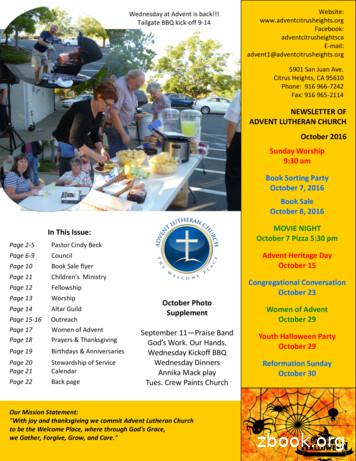October 4, 2011 (XXIII:6) Marcel Camus, BLACK ORPHEUS .
umé, Black Orpheus is hardly open to anauteurist appreciation—it stands alone, in the heat and on hotsytotsy legs. It is, of course, exposed to the kinds of sociopoliticalreadings that have become de rigueur in the years since itappeared, and it’s easy to look at Camus’ film with a jaundicedeye and see a white European man’s romanticized, evenorientalist, portrait of poor brown third worlders, for whompoverty is one long, breathless party.But let’s stop right there and consider that Carnivalitself is surely proof that these poor people party well enoughwithout any help from white Europeans, thank you, and that
Camus—BLACK ORPHEUS—3frowning on Black Orpheus for its rainbow romanticism is akinto damning the very musical traditions it celebrates. Before thelate fifties, when bossa nova exploded around the world—thanksin part to the success of this film—Americans thought of CarmenMiranda when they thought of South American culture, and herpersona and songs were only the tritest charades of ethnicity. Butthe music that runs through Black Orpheus like a river isauthentically native, and the rampant intoxication of the film’scharacters is not feigned, broadly speaking, for our benefit but isactually a manifestation of an entire culture exulting in its ownself-expression. Camus uses alocal, all-black cast ofnonprofessional actors andheaps in vast swatches ofCarnival footage, in case wewere in doubt. You see thesame identification between asociety and its giddy discoveryof voice in The Gold Diggers of1935, Jacques Demy’s TheUmbrellas of Cherbourg(1964), and Tony Gatlif’sLatcho drom (1993).Exultation is the wordto use, because whatever elseyou make of Camus’ film, it isan explosion of life love, acataract of élan. Viewers in1959 and beyond couldn’t be blamed for thinking that they’dnever seen sunlight properly filmed before. There is, indeed, nooverestimating the degree to which cinematographer JeanBourgoin’s Eastmancolor images rearranged fifties audiences’perceptions of Rio and its steep favelas (cleaned up though theywere), nor can we ignore the sheer opiate effect of so muchraging human color, sweat, rhythmic movement, and tropicalswelter. (Bourgoin’s versatility has also been undersung—astonishingly, he’d shot the black-and-white shadow nightmareof Welles’s Mr. Arkadin four years earlier.) Black Orpheus is, ofcourse, a stylized daydream, a vision of an entire city that won’tstop dancing, but still, the full thrust of “native cinema,”moderated though it was, may never have been so vividlyexperienced by mainstream Americans and Europeans. Thosetwo ideas—visual spectacle and cultural import—cannot beseparated here, particularly considering the extraterrestrial excessof Carnival, a one-of-a-kind optical drug. (“No one can resist themadness!” someone says.) The overall effect is of the wholestory unfurling while an epic, unceasing musical numbershimmies, bops, and wails in the background.Has any other movie worked up this kind of spritz,before or since? It’s not a small matter, either, to notice BlackOrpheus’s unabashed sexiness, which like its music and aerobicjoy—the film’s founding principles—radiates from it on analmost mythic scale. Given the film’s hedonistic program, it wasa brilliant gambit to use the Orpheus-Eurydice legend asscaffolding: once you’re in the land of demigods and ancientarchetypes, every human impulse can attain a cosmic weight, andwhat’s depicted concretely in Camus’ film is allowed to take on ametaphoric glamour, voicing all of humankind’s represseddesires and hungers. At the same time, Camus and his scenarist,Jacques Viot (working from a play, Vinicius de Moraes’s Orfeuda Conceição), don’t make a big deal about the mythologicalparallels—characters notice the confluence of names whentrolley driver Orfeu (soccer pro Breno Mello) meets and falls fornew girl in town Eurídice (Marpessa Dawn) and find thecoincidence merely amusing.Only children se
October 4, 2011 (XXIII:6) Marcel Camus, BLACK ORPHEUS/ORFEU NEGRO (1959, 100 min) Directed by Marcel Camus Written by Marcel Camus and Jacques Viot, based on the play Orfeu du Carnaval by Vinicius de Moraes . Produced by Sacha Gordine Original Music by Luiz Bonfá and Antonio Carlos Jobim Cinema
August 5, 2018 / 18th Sunday in Ordinary Time . 2 St John XXIII ST JOHN XXIII PARISH St. John XXIII Parish Office 1800 N. Wisconsin St. Port Washington, WI 53074 Rectory (262) 284 -4266 Fax (262) 284 -4216 Website
December 6, 2011 (XXIII:15) George Cukor, MY FAIR LADY (1964, 170 min.) Directed by George Cukor Book of musical play by Alan Jay Lerner From a play by George Bernard Shaw Screenplay by Alan Jay Lerner Produced by Jack L. Warner; James C. Katz (1994 restoration) Original Music by André Previn Cinematography by Harry Stradling Sr. Film Editing by William
Sunday Worship 9:30 am Book Sorting Party October 7, 2016 Book Sale October 8, 2016 MOVIE NIGHT October 7 Pizza 5:30 pm Advent Heritage Day October 15 Congregational Conversation October 23 Women of Advent October 29 Youth Halloween Party October 29 Reformation Sunday October 30 Our Mission Statement:
called to Rome for a conclave and is elected pope on Oc-tober 28, 1958 taking the name John XXIII. At age 76, he is the oldest pope to be elected in more than 200 years. On October 11, 1962, Pope John XXIII opens the first session of the Second Vatican Council, which set in mo-tion major reforms of the church, its structure, liturgy
Ashley Harris 2010 Blake Hartsook 2010 Denira Hasanovic 2010 Ella Heinicke 2010 Amber Heller 2010 . Ryan Coulson 2011 Dellanie Couture 2011 Emily Coy 2011 Allison Crist 2011 Kerrigan Crotts 2011 . Alexandra Hawks 2011 Trevor Heglin 2011 Marisa Heisterkamp 2011 Brett Heitkamp 2011 Caleb Helscher 2011
October 1 Family Caregiving 101: Difficult Topics 6 October 1 In Search of the Story of Beer 17 October 1 TEEN Black-Out Poetry 0 October 2 Wine Club 7 October 2,9,16, 23,30 Friday Features 96 October 4 Lyric Opera Lecture: Cinderella 15 October 5, 12, 19 Sewing Club 17 October 5 A Conversation with Mary Schmich 101
Miller Place, NY 11764 Email: BOE@millerplace.k12.ny.us Schedule of Business Meetings for 2010-2011 School Year September 22, 2010 October 27, 2010 November 17, 2010 December 22, 2010 January 26, 2011 February 16, 2011 March 30, 2011 April 27, 2011 May 18, 2011 June 22, 2011 July 5, 2011 *OTHER MEETINGS WILL BE SCHEDULED AND POSTED AS NEEDED .
ACCOUNTING 0452/22 Paper 2 October/November 2017 1 hour 45 minutes Candidates answer on the Question Paper. No Additional Materials are required. READ THESE INSTRUCTIONS FIRST Write your Centre number, candidate number and name on all the work you hand in. Write in dark blue or black pen. You may use an HB pencil for any diagrams or graphs. Do not use staples, paper clips, glue or correction .























